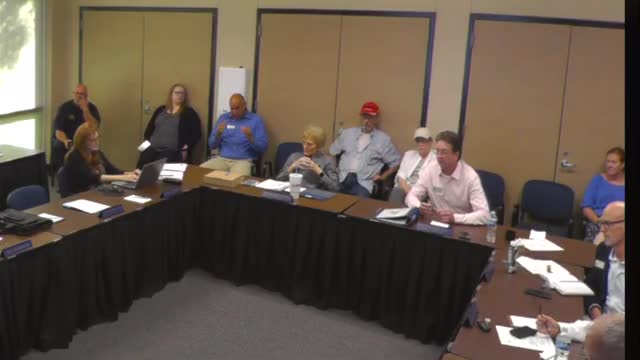Facility assessment: Highland Village police admin section sinking; engineers recommend foundation replacement for a 3,000 sq. ft. area
June 25, 2025 | Highland Village, Denton County, Texas
This article was created by AI summarizing key points discussed. AI makes mistakes, so for full details and context, please refer to the video of the full meeting. Please report any errors so we can fix them. Report an error »

Highland Village city staff on June 24 told the City Council that a recent facilities assessment found the administrative portion of the Police Department has experienced settlement and that architects and structural engineers recommend removing and replacing the foundation for an interior portion of the building.
Scott, a city staff member who discussed facilities findings, told the council the assessment found the administrative section of the police building had “sunk basically several inches.” He said the study identified moisture and expansive soils under the foundation and recommended removal and replacement of the foundation in roughly a 3,000-square-foot interior area that includes administrative spaces adjacent to the chief’s conference room and near the dispatch area.
Scott said the exterior walls and roof are separate from the interior structural issues and do not require removal, and he added, “the building's not gonna fall down on anybody anytime soon. However, it does need to be done. It's gonna continue to move.”
Scope and logistics: Scott described the scope as removal of interior walls and replacement of the foundation in the identified footprint followed by interior rebuild and said the project would displace police administrative staff for a period; he and others said dispatch operations are expected to remain functional and would likely not be affected. Council members asked about displacement costs and how staff would operate while work occurred; Scott said there are “means and methods” such as sound barriers to allow work while operations continue, but acknowledged the admin staff would be displaced.
Background and condition checks: staff said a prior survey showed the building stabilized after a drainage system was installed, but a new geotechnical/architectural review found deterioration in the perimeter drainage system and expansive soils beneath the foundation. Council members asked whether the city is monitoring settlement; staff said a later survey found the building was stable but warned that stabilizing requires keeping water away from the expansive soils.
Timing and budget context: staff placed facility improvements on a potential 2028 bond list and said construction funding could be budgeted for about 2029–2030. The assessment’s recommended repair is a substantial construction project and staff described it as a “big ticket” item that needs future prioritization and budgeting.
What the council did not do: council discussed the assessment and asked procedural questions but did not authorize construction or a specific expenditure at the June 24 meeting.
Next steps: staff said they will work with the council to prioritize facility projects and identify funding timing; engineering work for building-wide electrical upgrades has been funded for an upcoming budget year and staff indicated construction funding for that work would be considered next year.
Scott, a city staff member who discussed facilities findings, told the council the assessment found the administrative section of the police building had “sunk basically several inches.” He said the study identified moisture and expansive soils under the foundation and recommended removal and replacement of the foundation in roughly a 3,000-square-foot interior area that includes administrative spaces adjacent to the chief’s conference room and near the dispatch area.
Scott said the exterior walls and roof are separate from the interior structural issues and do not require removal, and he added, “the building's not gonna fall down on anybody anytime soon. However, it does need to be done. It's gonna continue to move.”
Scope and logistics: Scott described the scope as removal of interior walls and replacement of the foundation in the identified footprint followed by interior rebuild and said the project would displace police administrative staff for a period; he and others said dispatch operations are expected to remain functional and would likely not be affected. Council members asked about displacement costs and how staff would operate while work occurred; Scott said there are “means and methods” such as sound barriers to allow work while operations continue, but acknowledged the admin staff would be displaced.
Background and condition checks: staff said a prior survey showed the building stabilized after a drainage system was installed, but a new geotechnical/architectural review found deterioration in the perimeter drainage system and expansive soils beneath the foundation. Council members asked whether the city is monitoring settlement; staff said a later survey found the building was stable but warned that stabilizing requires keeping water away from the expansive soils.
Timing and budget context: staff placed facility improvements on a potential 2028 bond list and said construction funding could be budgeted for about 2029–2030. The assessment’s recommended repair is a substantial construction project and staff described it as a “big ticket” item that needs future prioritization and budgeting.
What the council did not do: council discussed the assessment and asked procedural questions but did not authorize construction or a specific expenditure at the June 24 meeting.
Next steps: staff said they will work with the council to prioritize facility projects and identify funding timing; engineering work for building-wide electrical upgrades has been funded for an upcoming budget year and staff indicated construction funding for that work would be considered next year.
Don't Miss a Word: See the Full Meeting!
Go beyond summaries. Unlock every video, transcript, and key insight with a Founder Membership.
✓
Get instant access to full meeting videos
✓
Search and clip any phrase from complete transcripts
✓
Receive AI-powered summaries & custom alerts
✓
Enjoy lifetime, unrestricted access to government data
30-day money-back guarantee

